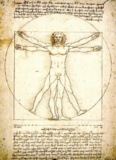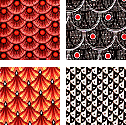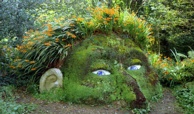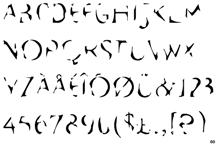iconocentrism, iconocentric - Iconocentrism is the belief or attitude that images (or icons) are or should be the central element in the universe. Images play the most important role, other things (the deity, people, objects, or text, perhaps) being subservient to them. Iconocentric is the adjectival form.
Quote:
"Since the days of Greek philosophy
sight has been hailed as the most excellent of the senses. The
noblest activity of the mind, theoria, is described in
metaphors mostly taken from the visual sphere. . . . Sight, in
addition to furnishing the analogues for the intellectual upperstructure,
has tended to serve as the model of perception in general and
thus as a measure of other senses."
Hans Jonas, The Phenomenon of Life, Toward a Philosophical
Biology (New York: Harper & Row, 1966), p. 135.
Also see analogue, anthropocentrism, ethnocentrism, and sight.
iconoclast, iconoclasm - Originally, one who destroys sacred religious images (or icons). The original iconoclasts destroyed countless works of art — religious images which were the subject of controversy among Christians of the Byzantine Empire, especially in the eighth and ninth centuries, when iconoclasm was at its height. Those who opposed images did not simply destroy them, although many were demolished; they also attempted to have the images barred from display and veneration. During the Protestant Reformation images in churches were again felt to be idolatrous and were once more banned and destroyed. In the nineteenth century "iconoclast" took on the secular sense that it has today: one who breaks traditions, doctrines, convictions, practices, etc. Dada artist Marcel Duchamp (French, 1887-1968) is the modern archetype of the iconoclast. Iconoclasm is the destruction of images. It can also be attacking of established beliefs. Iconoclastically and iconoclasticism are among many other formations made with the root "icono-."
Not all opposition to the display of images is iconoclasm. Extreme opposition is often more akin to censorship or expression of strong distaste.
Representational images can possess tremendous totemic power. Because to many people depictions can embody their subjects, images can be so offensive or transgressive that they are capable of inflicting pain in ways that transcend logic and aesthetics. Ancient Greeks used to chain statues to prevent them from getting away. Buddhists in Ceylon used to believe that once a painted figure's eyes were brushed in, the figure would come to life. Chris Ofili's painting with elephant dung, Holy Virgin Mary was at the center of controversy when shown at the Brooklyn Museum in 1999. Among others, the Catholic Church was offended. The mayor of New York threatened to eliminate funding for the museum. But there was no violence, nothing actually damaged. In early 2006, twelve caricatures (first appearing in the Danish newspaper Jyllands-Posten the previous September) satirizing Mohammad triggered protests, some violent, among Muslims of many nations. Muhammad was portrayed in one of the drawings wearing a turban in the shape of a ticking bomb. He stands at the gates of heaven, arms raised, saying to men who look like suicide bombers, "Stop, stop, we have run out of virgins." The newspaper justified its action by saying it was exercising its freedom of expression. (See Islam and Islamic art)
Violence has often been directed against offending objects, though rarely against the artists who made them.
Examples:
![]()
Byzantine iconoclasts whitewash the face of two
images of Christ, illumination
in a manuscript of the Middle Ages.
![]()
![]()
During the religious conflicts of Europe's
Reformation, these soldiers
are destroying Roman Catholic church pictures, crucifix, and
other objects at York Minster in the 16th century. See
crucifix.
![]()
![]() Hungarians toppled this colossal statue of Stalin
in their 1956 revolution against Soviet repression. Stalin
immediately crushed the rebellion. Destruction of images of despised
leaders is not considered iconoclasm, but these actions are interestingly
related to it. In 2003 similar photos were taken of
Hungarians toppled this colossal statue of Stalin
in their 1956 revolution against Soviet repression. Stalin
immediately crushed the rebellion. Destruction of images of despised
leaders is not considered iconoclasm, but these actions are interestingly
related to it. In 2003 similar photos were taken of Iraqis and American soldiers in Baghdad pulling down a statue of Saddam Husein from its pedestal.
Quote:
"What Scripture is to the educated,
images are to the ignorant, who see through them what they must
accept. They read in images what they cannot read in books."
Pope Gregory the Great, sixth century.
Also see aniconic, censorship, degenerate, effigy, First Amendment rights, iconomachy, iconomical, ugly, transgressive art, vandal, Vandals, vandalism, and xenophobia.
iconoduly, iconodulic, iconodule, and iconodulist - Iconoduly is the worship or veneration of images (or icons); iconolatry. Iconodulic is the adjectival form. An iconodule or an iconodulist is one who worships or serves images. This is the opposite of an iconoclast.
(pr. I:-kə-NAH-dyoo-lee, I:-kə-NAH-dyoo-lək, i:-KAHN-ə-dyool, and I:-kə-NAH-dyoo-ləst)
Also see advocacy, antiquarianism, art appreciation, audience, collect, collector, iconocentrism, idolatry, Islamic art, viewer, and votive.
iconogenetics, iconogenitor - Iconogenetics refers to the origins of images (or icons). An iconogenitor is the originator (generator) of an image.
(pr. i:-KAHN-ə-jə-NEH-təks, i:-KAHN-oh-JEN-ə-tər)
Also see artist, creativity, iconocentrism, iconographer, iconoplast, memory, new, and originality.
iconography, iconograph, iconographer - Iconography is the pictorial representation of a subject, or the collected images (or icons) illustrating a subject — pictures, diagrams, etc. Iconography can mean the description of representational works of art. Also, the study of subject matter and symbolism in the visual arts, as in collections of pictures constituting a complete visual record of a subject, or a visual dictionary.
Semiotics includes studies of iconography, as well as studies of iconology and typology.
Iconograph has been used to mean an engraving or other picture or illustration for a book. An iconographer is a maker of such images.
(pr. i:'cuh-nah"greh-fee)
Also see crown, images, icon, iconogenitor, iconoplast, lexicon, plate, snake, symbol, taxis, and tradition.
iconolagny - Sexual stimulation from images (or icons). Also see erotica, obscene, and pornography.
iconolatry, iconolater - Iconolatry is the worship or veneration of images (or icons); iconoduly. Iconolatric is the adjectival form. An iconolater is one who worships or serves images.
(pr. I:-kə-NAH-lə-tree and I:-KAH-nə-LAY-tər)
Also see advocacy, aniconic, antiquarianism, art appreciation, collect, collection, collector, iconocentrism, iconography, and iconomania.
iconology - The branch of knowledge which deals with the subject of icons (or images); also the subject matter of this study, icons collectively, or as objects of investigation. Or, symbolical representation; symbolism.
(pr. I:-kə-NAH-lə-jee)
Semiotics includes studies of iconology, as well as studies of iconography and typology.
Other formations include iconological and iconologist.
Related link:
Also see aniconic, communication, cryptic, expression, graphic design, iconocentrism, iconomachy, meaning, memory, mind, and nuance.
iconomachy, iconomach - A war against images (or icons); hostility or opposition to images, especially to use of images in religious worship. An iconomach is a person who is hostile to images, as are some iconoclasts.
(pr. I:-kə-NAH-mə-kee and I:-KAH-nə-MAK)
Quote:
"We are similar to God only in our
souls, and no image can represent him. That is why people who
try to represent the essence of God are madmen. For even their
souls of little worth cannot be represented."
Jean Calvin (1509-1564), French-born Swiss theologian of the
Reformation, quoted in Sergiusz Michalski, The Reformation
and the Visual Arts, London: Routledge, 1993, p. 62.
Also see aniconic, censor, degenerate, destroy, fascist aesthetic, First Amendment rights, iconoclast, iconology, iconophobia, iconophobiac, iconophobic, Islamic art, sacrilege, transgressive art, ugly, vandal, vandalism, and xenophobia.
iconomancy - Divination using images (or icons).
(pr. I:-KAH-nə-MAN-see)
Also see feng shui.
iconomania, iconomaniac - An infatuated devotion to images (or icons), or a mania for collecting icons or images. An iconomaniac is a person who is extremely and excessively interested in images.
(pr. I:-KAH-no-MAY-nee-ə, I:-KAH-no-MAY-nee-ak)
Also see advocacy, antiquarianism, art appreciation, art buyer, art criticism, art history, artist, audience, iconocentrism, iconoduly, iconolater, iconolatry, iconophile, idolatry, and viewer.
iconomatic - Using images (or icons) to represent sounds of words.
Also see auditory, hieroglyphics, pictograph, and text.
iconometer - An instrument with which to measure the size of or distance to an object by measuring its image (or icon). Sometimes an iconometer is a photographic viewfinder, separate from a camera.
(pr. i:-KAH-nə-MEE-tər or I:-kə-NAH-mə-tər)
An example of this last type:
An iconometer, c. 1863. "It consists
of a small lens, a camera, of the shape of an opera-glass, and
a square focussing glass. By turning the lens towards the view
it is represented reversed on the ground glass; and in this way
the operator can judge whether his large camera will take in
the whole or what portion of the required view."
Désiré van Monckhoven, A Popular Treatise on
Photography. Translated By W.H. Thornthwaite. London, 1863.
Quotation from Stanford University's Albumen site.
Also see mechanical scale.
iconomical - Iconoclastic; opposed to using images (or icons) as objects of worship or veneration.
iconophilia, iconophile - Iconophilia is the love of images (or icons). An iconophile (or iconophilist) is a connoisseur, a person who loves images.
(i:KAH-nə-FEE-lee-ə, i:-KAH-nə-FI:L)
Also see art buyer, art criticism, art history, artist, iconocentrism, iconolater, iconolatry, iconomania, iconomaniac, idolatry, and xenophilia.
iconophobia, iconophobiac, iconophobic - Iconophobia is fear or anxiety about images (or icons). An iconophobiac is a person who experiences this fear. Iconophobic is the adjectival form.
(pr. i:-KAH-nə-FOH-bee-ə, i:-KAH-nə-FOH-bee-ak, i:-KAH-nə-FOH-bək)
Also see aniconic, censor, degenerate, destroy, fascist aesthetic, fig leaf, gymnophobia, iconoclast, iconology, iconomachy, Islamic art, sacrilege, transgressive art, ugly, vandal, vandalism, and xenophobia.
iconophor, iconophoric, meta-iconophor - An iconophor is an image whose first distinctive feature consists of the letter which begins the name of its referent. "Iconophoric" is the adjectival form. A meta-iconophor is an image whose first distinctive feature consists of the letter which begins the name of a referent that is connoted, not denoted by the image.
(pr. i:-KAH-nə-FOR, i:-KAH-nə-FOR-ək, MEH-tə i:-KAH-nə-FOR)
iconoplast - A person who makes images (or icons).
(pr. i:-KAH-nə-PLAST)
Also see artist, iconogenitor, and iconographer.
![]() iconoscope - A sealed glass tube in early (1930s and 40s) video cameras
in which light is converted into electric
waves.
iconoscope - A sealed glass tube in early (1930s and 40s) video cameras
in which light is converted into electric
waves.
It was invented in 1929 by the American Viadimir Zworykin. The tube has a vacuum-tight glass envelope. At its center is a dielectric plate, one surface of which is coated with a thin uniform layer of metal, the other with a mosaic of thousands of tiny metal elements which release electrons when illuminated. The image is focused onto this mosaic, which makes up a series of mini-condensors. An electron beam bombards these, one after the other. The amount of charge collected is proportional to the charge on each condensor, and therefore to the strength of illumination of each element.
(pr. i:-KAH-nə-skohp)
iconostasis - In Eastern Christian churches, a screen or partition, with doors and many tiers of icons, that separates the sanctuary from the main body of the church.
(pr. i:-KAH-nə-STAY-səs)
Example:
![]()
Russia, Portable Iconostasis, mid-16th century,
tempera on 15 wood
panels, Milwaukee Art Museum, WI.
Although this portable iconostasis is a small-scale
version of larger sanctuary screens, it follows the usual format
with images of Christ as Savior in the center, Old Testament
Prophets on the upper story, Church feast days on the second
story, and a solemn procession of angels
and saints below.
Related link:
Also see aniconic, Byzantine art, cathedral, deesis, and iconomachy.
 icosahedron - A polyhedron
having twenty triangular faces.
icosahedron - A polyhedron
having twenty triangular faces.
The faces of a regular icosahedron are all equilateral
triangles.
The regular
icosahedron is one of the five Platonic solids (along with the
tetrahedron, hexahedron
(cube), octahedron,
and the dodecahedron).
The icosahedron vacuus was drawn by Leonardo da Vinci (Italian,1452-1519) for the "De divina proportione" treaty by Luca Pacioli, in which the Renaissance artist and the mathematician define rules determining what is beautiful.
The plural can be either icosahedrons or icosahedra.
Examples:
Fra Giovanni da Verona (Italian), three panels of wood intarsia, 1520: Each conveys the appearance of open cupboard doors — a trompe l'oeil effect resulting from the use of linear perspective. The first panel: a Campanus sphere, a mazzocchio, and various instruments of the geometer. The second panel: a complex polyhedron which can be constructed by erecting a pyramid of equilateral triangles on each face of an icosidodecahedron. The third: the Campanus sphere again, along with an icosahedron and a truncated icosahedron.
59 stellated icosahedra, contemporary computer generated images by Dr. R. Mäder.
Also see mathematics, polygon, and vertex.
ideal - A theory or conception of something in its absolute perfection. Or, a standard or model of excellence. Also, an ultimate object of endeavor; a goal. And, an honorable or worthy principle or aim.
Example:

Leonardo da Vinci (Italian, 1452-1519), Study
of proportions, from Vitruvius's De Architectura,
pen and ink,
13 1/2 x 9 5/8 inches (34.3 x 24.5 cm), Accademia, Venice. Leonardo,
inspired by the mathematician
Vitruvius (Roman, 1st century BCE),
drew this famous picture of Vitruvian Man — a sort of ideal
figure — whose arm
span is equal to his height
— a ratio of one, or 1:1.
See a page with a math lesson plan for grades 6-8,
as well as articles on drawing,
proportion, and Renaissance.
Also see archetype, avatar, exemplar, icon, idealism, idealization, and standards.
idealism - The pursuit of things in an ideal form. In philosophy, any of several theories (principally of Berkely, Hegel, and Kant) which hold that reality has no objective existence but is produced in some way by the mind.
Quote:
Also see idealization and Surrealism.
idealistic - Of, relating to, or having the nature of idealism.
idealization - The representation of things according to a preconception of ideal form or type; a kind of aesthetic distortion to produce idealized forms. A possible motive might be to make things appear as they would if the world were perfect.
Also see anime, Apollo, archetype, avatar, exemplar, idealism, nude, style, and stylize.
idealized - Regarded or treated as ideal, or made or envisioned as ideal.
Also see aesthetic, anime, style, and stylize.
identity - The characteristics by which a thing (e.g. a product, event, fictional character, concept), a person, or a people (a company, government, or other organization) is definitively known — as any of these might be identified by a name, signature, sign, symbol, portrait, monogram, flag, heraldic crest, seal, logo, trademark, etc. "Identity" refers to individuality in some ways, and sameness (identical) in others.
When the identity of the artist who produced a work has not been established, the artist might be noted as anonymous, unidentified, unknown, school of . . . , circle of . . . , studio of . . . , attributed to . . . , among other such labels.
Any person's identity can be understood only as shifting and ever-changing in two ways. First, identity is not fixed: it changes over the course of a lifetime. Second, identity is how one is perceived by others. Resemblance is relative to the culture and the purpose of classification. Many artists have explored issues concerning their own as well as other people's identities, sometimes in the context of interpersonal, intrapersonal, gender, feminist, racial, spiritual, class, or political issues.
A mask is something that can be used to conceal a person's identity.
An avatar (originating in Hinduism as an incarnation of a god) is an archetype (an embodiment, as of a quality or a concept) or, in cyberspace (online, in virtual reality, chat rooms, or in video or computer games) an avatar is an image, often movable, used to represent or substitute for a user.
Quote:
Also see copyright, graphic design, icon, ideogram, letterhead, pseudonym, self-portrait, semiotic, and stereotype.
ideogram - A simple picture-like sign or graphic symbol used either in a signage or a writing system, so that it represents a thing or an idea instead of a letter or specific word, as does the common symbol for "no smoking" or many of the characters used in Chinese writing. In typography, ideograms are often available in fonts known as dingbats.
(pr. I-dee-o-gram)
A very early example:

Iraq, Uruk, Document
Consisting of Ideograms, late 4th-early 3rd millennium
BCE,
stone, 4.3 x 2.3 cm, Hermitage
Museum, St. Petersburg, Russia.
Also see cuneiform, flag, glyph, heraldic crest, heraldry, hieroglyphics, icon, letterhead, lettering, logo, monogram, petroglyph, pictograph, and text.
ideology - A body of ideas reflecting the social needs and aspirations of an individual, a group, a class, or a culture; examples are ethnocentrism and class consciousness. A set of doctrines, beliefs, or ideals that form the basis of a political, economic, or other system which attempts to put experience of the world into some order. The result, particularly in Marxist thought, is a distortion of reality to maintain authority over it. Various applications of this sense of the word can be found in feminism and other types of critical activity, often very politically oriented. Others use the term with less political load, meaning one type of symbolic system among others, like art, religion, and science.
Also see existentialism, formalism, humanism, multiculturalism, and other isms.
idiom - A style or technique characteristic of an individual artist, period, movement, or medium. A potter might be said to be working in the idiom of early New England potters; or a painter, that she or he works in the abstract expressionist idiom.
I.E.P. - Acronym for Individualized Education Program.
igneous rock - Rock formed by the cooling and solidifying of the subterranean molten mass of the earth. Examples of igneous rocks include: basalt, diorite, dolerite, granite, granodiorite, obsidian, and porphyry.
Also see metamorphic rock, Mohs Scale of Hardness, sedimentary rock, and stone.
ikebana - Literally Japanese for "living flowers,"
ikebana is the Japanese
art of formal floral arrangement.
Also known as kado, it is based upon a study of the "way
of flowers," resulting in practitioners' showing special
regard to balance, harmony,
and form. Attention
is paid to the vase or other vessel in which the plant material
is composed. Ikebana has a history
of at least seven centuries, and has come to  embrace
several distinct types or styles of
arrangement These categories include arrangements of
embrace
several distinct types or styles of
arrangement These categories include arrangements of standing flowers — rikka;
living  flowers
-- seika or shoka;
flowers
-- seika or shoka;
and flung flowers —nageire.
Some types of ikebana depend more heavily on the kinds of containers
used, such as arrangements made in tall vases — heika;
bowl-shaped
vases and plate-like containers on which flowers are essentially
piled up — moribana. What most sets ikebana apart from
Western approaches to making floral arrangement is the Japanese
emphasis on elegant
simplicity, in contrast to
the Western tendency toward densely
layered arrangements. Ikenobo is the oldest system or school
of flower arrangement. Jiyuka is a free style of flower
arranging. Chabana is another style of Japanese flower
arranging used specifically in the tea ceremony (see chado). A
kadoka is a practitioner of ikebana. A kenzan is a "frog
pin," a device used to keep flowers positioned. A komi
is a forked stick used to hold flowers in a vase. Kiri-dame
is a method of way of cutting stems in order to shape
and curve them. Oshi-dame
is "a pushing method" for shaping and curving stems.
Also see asymmetry, bonsai, botanical, design, and still life.
illuminated manuscript - See illumination and manuscript.
illusion - A deceptive or misleading image or idea.
An example:

Maurits Cornelis Escher (Dutch, 1898-1972),
Balcony, 1945, lithograph,
11 3/4 x 9 1/4 inches (29.7 x 23.4 cm), National Gallery of Art,
Washington, DC. In the center of this picture of a hillside town,
Escher said he tried to break up the paper's flatness
by "pretend[ing] to give it a blow with my fist at the back,
but . . . the paper remains flat, and I have only created the
illusion of an illusion." See optical
illusion.
Quote:
Also see appearance, copy, counterfeit, fake, forgery, irony, likeness, magic lantern, mirror, perspective, push and pull, realism, reflection, reification, representation, simulacrum, simulation, theater, trompe l'oeil, truth, verisimilitude, virtual, and virtual reality.
illustrate - To create designs and pictures for books, magazines, or other print or electronic media to make clear or explain the text or show what happens in a story.
illustration board - A bristol board made with a close weave. Illustration board is a strong, heavy paper or card appropriate as a support for pencil, pen, watercolor, collage, etc. It is more archival if it is acid-free.
Also see oaktag.
illustrator - Among those in art careers, a person who creates designs and pictures for books, magazines, or other print or electronic media. Specialties among illustrators include fashion illustrator and medical illustrator.
Related resource:
Also see graphic designer.
image - A picture, idea, or impression of a person, thing, or idea; or a mental picture of a person, thing, or idea. The word imagery refers to a group or body of related images.
Quote:
Links to huge collections of images:
Related resources:
Also see copyright, icon, iconocentrism, iconogenetics, iconography, iconology, iconomania, mirror, new media, photography, picture, pixel shim, positive, reproduction, slide, and weight.
image capture - Employing a device, such as a scanner, to create a digital representation of an image. This digital representation can then be manipulated with and stored on a computer.
Also see camera-ready.
image manipulation - Making changes (manipulation) to a digital image using image processing.
Also see Photoshop.
image processing - The alteration or manipulation of images that have been scanned or captured by a digital recording device. Can be used to modify or improve the image by changing its size, color, contrast, and brightness, or to compare and analyze images for characteristics that the human eye could not perceive unaided.
image scanner - See scanner.
![]()



imbrication - An overlapping, as of tiles, shingles, feathers or scales for instance. There is a basket-weaving technique called imbrication.
Also see kern and kerning.
imagines - In ancient Rome, wax portraits of ancestors.
(pr. ə-MA-jə-NEEZ)
This is the plural form of the word; the singular form is imago.
Example:
Roman, Sculpture of a Roman with "Senator's shoes" holding imagines maiorum, stone.
imago - See imagines.
imitationalism - An aesthetic theory of art which places emphasis on the literal qualities. According to this theory, the most important thing about a work of art is the realistic representation of subject matter. A work is considered successful if it looks like and reminds the audience of what is seen in the real world.
Also see appropriation, copy, counterfeit, emotionalism, forgery, formalism, homage, likeness, and simulacrum.
immutable - Not subject to change; permanent.
(pr. im-MYOO-tə-bəl)
Quote:
Also see art conservation, art restoration, permanent pigment, time, and vanitas.
impasto - A thick or lumpy application of paint, or deep brush marks (brushstrokes), as distinguished from a flat, smooth paint surface. May also refer to a thick application of pastel.
(pr. im-PAHS-toh)
Examples of paintings made with impasto technique:

Vincent van Gogh (Dutch, 1853-1890), Cypresses, June 1889 (Saint-Rémy),
oil on canvas,
36 3/4 x 29 1/8 inches (93.3 x 74 cm), Metropolitan Museum of
Art, New York, F 613. Also see Post-Impressionism.

Jean-Paul Riopelle (French-Canadian, 1923-2002),
Perspectives, 1956, oil
on canvas, 80.6 x 100.0 cm,
Tate Gallery, London. See Canadian
art.

Frank Auerbach (English, born Germany, 1931-),
The Sitting Room, 1964, oil
on board, 128.2 x 127.7 cm, Tate Gallery, London.
Related resource:
Also see encaustic, expressionism, and modeling.
implied - Something that is suggested or inferred, rather than directly apparent.
Examples:

English, Mud Man, 20th century, in The Lost Gardens of Heligan, Cornwall, England. One might wonder if more of this giant (implied) will emerge while we are standing beside him! This is an earthen mound supporting various plants, carved stone [or are they cement?] ears, and glazed ceramic eyes. Another photo, taken earlier. See earth art.

Commonworld, a contemporary font, its letters — distressed and partly missing — are implied. Available from Fontscape.com. See lacuna and typography.
Also see ambiguity, definition, lacuna, line, and shard.
impluvium - In the architecture of ancient Rome, a depression in the floor of an atrium to collect rainwater.
Example:
![]()

![]()
In an ancient Pompeiian home, its atrium and impluvium.
![]()

![]()
impost block - In architecture, a stone with the shape of a truncated, inverted pyramid, placed between a capital and the arch that springs from it. In the illustration, the impost blocks appear to be square platforms on top of the columns.
Example:
Psalmodi, marble column, Corinthian style capital with its impost block from a late Romanesque cloister. See column and marble.
Also see springing.
impression - In general, an effect, a feeling, an image, a percept, or a (usually vague) memory. In printmaking, a single print made from a block, plate, or stone; or the act of impressing — the contact between the printing surface and the surface on which the print is made. Sometimes refers more loosely to a mark left on a surface by pressing something against it, or to a single or initial coat of color.
Example:

El Greco, born Domenikos Theotocopoulos (Spanish,
born Greece, 1541-1614), St. Veronica, 1576-79, oil
on canvas, 84 x 91 cm, Museum
of Santa Cruz, Toledo, Spain. Veronica wiped Christ's face as
he carried the cross to his crucifixion.
Miraculously, an impression of his face remained on the towel.
See Mannerism.
Also see attention, consciousness, context, déjà vu, gestalt, mpressionism, knowledge, memory, optical, optical illusion, optical mixing, perception, seeing, and subliminal message or subliminal advertising.
https://inform.quest/_art